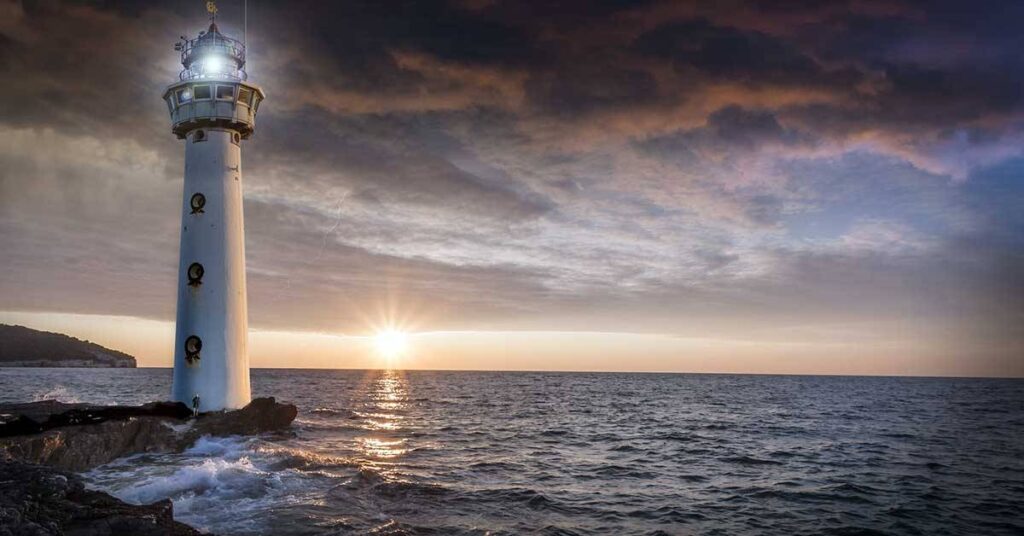Introduction
A lighthouse is a tall, sturdy tower equipped with a powerful light and designed to guide ships safely to shore. For centuries, lighthouses have played a crucial role in maritime safety, guiding mariners through treacherous waters and warning them of hidden hazards such as rocky shores, underwater reefs, and shallow waters. Throughout the ages, these legendary landmarks have undergone transformations, yet they continue to embody a reassuring presence, offering direction and inspiration to those navigating the seas.
For thousands of years, lighthouses have stood as be series of remarkable events and enduring customs. The earliest recorded lighthouse, the Pharos of Alexandria, dates back to approximately 280 BCE, when it was built in ancient Egypt for centuries, this renowned beacon stood watch over the thriving port for sailors charting their course through the crowded waters .Over the centuries, lighthouses spread across the world, becoming essential for maritime trade and safety.
During the Middle Ages, lighthouses were maintained by monasteries and local authorities. The 18th and 19th centuries saw significant breakthroughs in technology, including the introduction of Fresnel lenses, which greatly improved the effectiveness of lighthouses by increasing the range at which their beacons could be seen.
How Do Lighthouses Work?
Modern lighthouses are equipped with advanced lighting and signaling systems. Here’s a breakdown of their key components:
Tower Structure: The tower provides elevation for the light, allowing it to be seen from far away.
Lens and Lamp: A powerful lamp is focused through a lens system, often a Fresnel lens, to create a concentrated beam of light.
Light Characteristics: Lighthouses have unique light patterns, such as flashes or colors, to help mariners identify their location.
Automation: Many lighthouses today are automated, requiring minimal human intervention.
The Role of Lighthouses
What is the lighthouse’s primary purpose? Its role extends beyond just illuminating the sea. Lighthouses:
Guide Ships: They act as navigational aids, guiding ships to ports and through hazardous waters.
Warn of Dangers: Lighthouses alert sailors to potential obstacles like rocky coastlines or sandbars.
Mark Safe Passage: They indicate safe routes and channels for vessels.
Provide Landmarks: Lighthouses serve as reference points, helping mariners calculate their position.
Renowned Beacons of the Globe
A select few lighthouses have earned distinction for their rich heritage and stunning design, including the Pharos of Alexandria, a legendary structure that was once counted among the Seven Wonders of the Ancient World.
Eddystone Lighthouse, England: A marvel of engineering, built on a rocky reef.
Cape Hatteras Lighthouse, USA: The tallest brick lighthouse in the world.
Peggy’s Cove Lighthouse, Canada: A picturesque lighthouse drawing millions of visitors annually.
Jeddah Light, Saudi Arabia: The world’s tallest lighthouse, standing at 436 feet.
Preserving Lighthouses
Many lighthouses have become obsolete due to modern technology like GPS and radar. However, their cultural and historical importance ensures they are preserved:
For lates news
Restoration Efforts: Many orgaThe Lighthouse as a Symbol
nizations work to restore and maintain historic lighthouses.
Tourism: Lighthouses are popular tourist destinations, providing income for their upkeep.
Education: Lighthouses serve as educational sites, teaching visitors about maritime history and safety.
What is the lighthouse in literature and art? It often represents hope, guidance, and resilience. Its light cutting through darkness is a metaphor for overcoming adversity, making lighthouses an enduring symbol of human perseverance.
Challenges Facing Lighthouses
Despite their charm, lighthouses face challenges:
Erosion and Climate Change: Rising sea levels and storms threaten coastal lighthouses.
Neglect: Many lighthouses fall into disrepair without proper funding.
Technological Advancements: GPS and electronic navigation systems have reduced the reliance on lighthouses.
Beyond its practical use as a guide, it stands as a shining example of human innovation and a reassuring presence for those at sea. While modern technology has reduced its functional necessity, the lighthouse remains a cultural icon, preserving its legacy through tourism and conservation efforts. Its light continues to inspire, guiding us not just across seas but through the challenges of life.









